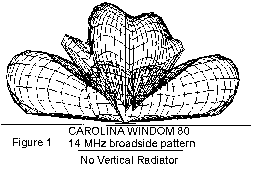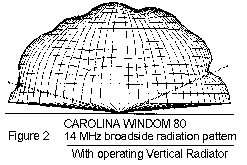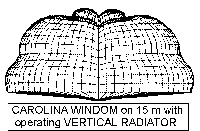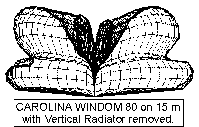|
To illustrate the effectiveness of the Vertical Radiator in a CAROLINA WINDOM 80 supported at 50 feet in the air over a ground model of good soil and no major hills. The only difference between the two antennas is the presence or absence of the Vertical Radiator. The pattern in figure 1 was generated with the Vertical Radiator removed. The pattern is similar to what we would expect to see from what is essentially an 80 meter Double Zepp operating on 14 MHz. |
 |
|
|
In figure 2, the CAROLINA WINDOM 80 is operating in its usual fashion with the Vertical Radiator working. Note how the radiation pattern improves at increasingly lower takeoff angles. The Vertical Radiator provides all the improvement seen below the dotted lines in figure 2. That improvement amounts to several dB depending on the takeoff angle, angles which are important for DX operation. |
 |
|
|
Actually, the antenna in figure 1 has proven itself to be an excellent performer over the years. The Double Zepp has long been recognized as an exceptional DX antenna. Combine the Double Zepp's performance with the added gain of the CAROLINA WINDOM's Vertical Radiator system and you can see why many operators, including one magazine columnist, report performance comparable to small Yagis. |
||
Just to show that this is not a single band fluke, here are the patterns for 15 m. |
 |
|
 |
||